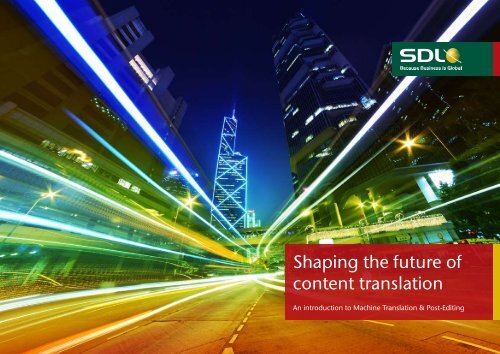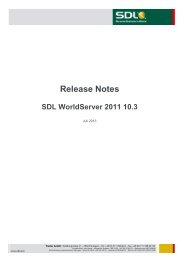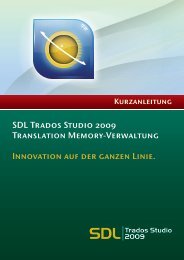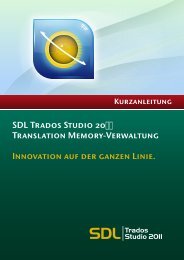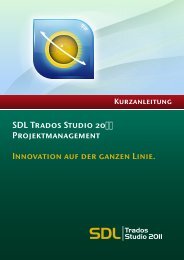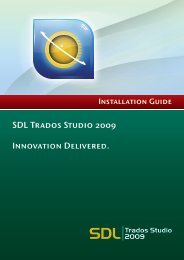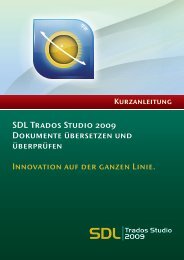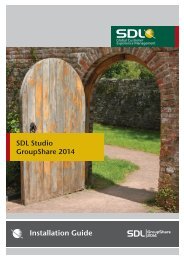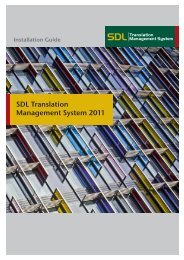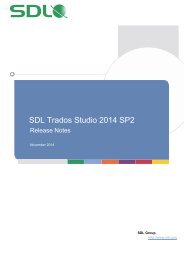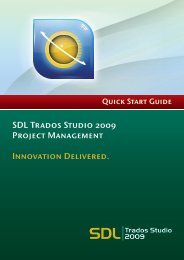Shaping the future of content translation - SDL
Shaping the future of content translation - SDL
Shaping the future of content translation - SDL
Create successful ePaper yourself
Turn your PDF publications into a flip-book with our unique Google optimized e-Paper software.
<strong>Shaping</strong> <strong>the</strong> <strong>future</strong> <strong>of</strong><br />
<strong>content</strong> <strong>translation</strong><br />
An introduction to Machine Translation & Post-Editing
<strong>Shaping</strong> <strong>the</strong> <strong>future</strong> <strong>of</strong> <strong>content</strong> <strong>translation</strong> www.sdl.com/language-technology | 2<br />
Contents<br />
Introduction 03<br />
What do we mean by Machine Translation 05<br />
and why do we need it<br />
How Machine Translation can benefit 14<br />
your organization<br />
Post-Editing success stories 16<br />
An introduction to Post-Editing 08<br />
How to choose your MT tool 20<br />
How to make <strong>the</strong> most <strong>of</strong> Post-Editing 10<br />
Maximizing <strong>the</strong> value <strong>of</strong> MT 22<br />
The art <strong>of</strong> Post-Editing 12<br />
Getting started with MT 24
<strong>Shaping</strong> <strong>the</strong> <strong>future</strong> <strong>of</strong> <strong>content</strong> <strong>translation</strong><br />
www.sdl.com/language-technology | 3<br />
Introduction<br />
Andy Reid, Product Marketing Manager, <strong>SDL</strong><br />
In 2013 we are all part <strong>of</strong> <strong>the</strong> global<br />
economy. The last 20 years have<br />
seen huge advances in international<br />
trade meaning it is now far easier to<br />
do business in new markets. Today,<br />
customers want to buy products across<br />
numerous countries, but via <strong>the</strong> same<br />
identical purchasing process.<br />
This change has been accelerated by <strong>the</strong><br />
proliferation <strong>of</strong> <strong>the</strong> internet, ecommerce<br />
and mobile commerce. Every year we<br />
sell more and more online.<br />
$33<br />
US mCommerce *<br />
sales are expected<br />
to hit $33bn in 2015<br />
eMarketer, Nov 2011<br />
billion<br />
*M-commerce (mobile commerce) is <strong>the</strong> buying and selling <strong>of</strong> goods and<br />
services through wireless handheld devices such as cellular telephones or tablets
<strong>Shaping</strong> <strong>the</strong> <strong>future</strong> <strong>of</strong> <strong>content</strong> <strong>translation</strong><br />
www.sdl.com/language-technology | 4<br />
Introduction<br />
Andy Reid, Product Marketing Manager, <strong>SDL</strong><br />
However, with new opportunities<br />
come new responsibilities. Selling<br />
could be just <strong>the</strong> start <strong>of</strong> <strong>the</strong><br />
relationship with a customer and<br />
<strong>the</strong>y will expect post-sales support,<br />
customer service and a continued<br />
presence in <strong>the</strong>ir market to maintain<br />
credibility. These are some <strong>of</strong> <strong>the</strong><br />
drivers for <strong>the</strong> creation <strong>of</strong> new<br />
<strong>content</strong> in multiple languages, and<br />
it’s not a trend that is likely to slow<br />
down any time soon.<br />
Customers will expect online and<br />
social interactions to occur in <strong>the</strong>ir<br />
native language. ‘Going Global’ is<br />
not just about translating marketing<br />
collateral, it’s about ensuring that<br />
all <strong>content</strong> is accessible to as many<br />
customers as possible, in a language<br />
<strong>the</strong>y instantly understand. That<br />
includes editorial, user generated<br />
reviews and knowledge bases.<br />
It is estimated that 2.5 quintillion<br />
(10 18 ) bytes <strong>of</strong> data are created<br />
every day, meaning we need more<br />
translated <strong>content</strong> than ever before<br />
and <strong>the</strong>re simply aren’t enough<br />
translators in <strong>the</strong> world to keep up<br />
with demand. Something needed<br />
to change and now it has. As <strong>the</strong><br />
problem can’t be helped with<br />
human resources alone, we have<br />
to look to technology to help.<br />
Machine Translation (MT) is <strong>the</strong> key<br />
to keeping up with demand and<br />
staying ahead <strong>of</strong> <strong>the</strong> game.<br />
0.00000067%<br />
In 2012, only<br />
0.00000067% <strong>of</strong> all<br />
<strong>content</strong> generated<br />
was translated.<br />
Common Sense Advisory, 2011
<strong>Shaping</strong> <strong>the</strong> <strong>future</strong> <strong>of</strong> <strong>content</strong> <strong>translation</strong> www.sdl.com/language-technology | 5<br />
What do we mean by Machine Translation<br />
Machine Translation:<br />
Automated<br />
<strong>translation</strong> that<br />
uses s<strong>of</strong>tware<br />
to translate text<br />
from one natural<br />
language to<br />
ano<strong>the</strong>r.<br />
Daniel Marcu, MT Evangelist, 2013<br />
The desire to get a machine to<br />
perform this complex human activity<br />
has a long history that has been<br />
spurred on at various stages during<br />
its development. In times <strong>of</strong> war<br />
machine <strong>translation</strong> has been used<br />
to accelerate <strong>the</strong> <strong>translation</strong> <strong>of</strong> large<br />
volumes <strong>of</strong> monitored <strong>content</strong>. More<br />
recently <strong>the</strong> growth <strong>of</strong> <strong>the</strong> internet<br />
and globalization has driven <strong>the</strong> need<br />
for more cost effective methods <strong>of</strong><br />
<strong>translation</strong>. As a result <strong>of</strong> continued<br />
development, new paradigms and<br />
an increase in desktop computing<br />
power, machine <strong>translation</strong> now<br />
achieves a performance that enables it<br />
to be deployed commercially as part<br />
<strong>of</strong> a high quality <strong>translation</strong> process.<br />
For some, <strong>the</strong>ir only interaction<br />
with machine <strong>translation</strong> will be<br />
an application on a mobile. O<strong>the</strong>rs<br />
may experiment fur<strong>the</strong>r with instant<br />
<strong>translation</strong> <strong>of</strong> chat sessions on social<br />
networks, or conversion <strong>of</strong> foreign<br />
web pages into a different language.<br />
While <strong>the</strong>se are common uses <strong>of</strong><br />
what we call machine <strong>translation</strong>,<br />
it’s far more powerful in <strong>the</strong> hands<br />
<strong>of</strong> experts and its power reaches<br />
beyond personal use and into <strong>the</strong><br />
corporate domain.
<strong>Shaping</strong> <strong>the</strong> <strong>future</strong> <strong>of</strong> <strong>content</strong> <strong>translation</strong> www.sdl.com/language-technology | 6<br />
What do we mean by Machine Translation<br />
There are two main types <strong>of</strong> application for MT<br />
1<br />
2<br />
Where <strong>the</strong> MT output is used directly to get<br />
an understandable <strong>translation</strong>.<br />
Typically this is short life <strong>content</strong> where <strong>the</strong><br />
meaning <strong>of</strong> <strong>the</strong> original can be understood from<br />
<strong>the</strong> MT output.<br />
As tool that improves <strong>the</strong> efficiency <strong>of</strong> high<br />
quality <strong>translation</strong>.<br />
The MT helps <strong>the</strong> human translator achieve a high<br />
quality output by providing an initial <strong>translation</strong>.<br />
The process is referred to as MT plus post-editing.<br />
In both <strong>of</strong> <strong>the</strong>se cases <strong>the</strong> performance <strong>of</strong> <strong>the</strong> MT is<br />
enhanced by training <strong>the</strong> engine for <strong>the</strong> <strong>content</strong> that is<br />
being translated so that <strong>the</strong> terminology and style are<br />
appropriate. This is especially important for technical<br />
documentation where <strong>the</strong> correct use <strong>of</strong> terminology<br />
is very important for understanding and for achieving<br />
high quality in publishable <strong>content</strong>. This additional<br />
training over and above <strong>the</strong> basic language training<br />
for MT engines is known as customization and is a big<br />
differentiator from <strong>the</strong> free online systems where one<br />
size fits all.<br />
For many types <strong>of</strong> <strong>content</strong>, raw MT output is sufficient<br />
for purpose. It is capable <strong>of</strong> producing fluid, accurate<br />
and naturalistic output and for <strong>the</strong> purpose <strong>of</strong><br />
‘understanding’ this is more than sufficient. It is a<br />
cheap, fast and efficient way to access information<br />
that would o<strong>the</strong>rwise remain outside your reach. But<br />
for some <strong>content</strong> types, <strong>the</strong> requirement will be for<br />
polished, publishable <strong>content</strong> that retains brand voice.
<strong>Shaping</strong> <strong>the</strong> <strong>future</strong> <strong>of</strong> <strong>content</strong> <strong>translation</strong><br />
www.sdl.com/language-technology | 7<br />
Q<br />
A<br />
So <strong>the</strong> choice is simple -<br />
companies ei<strong>the</strong>r choose<br />
MT or human <strong>translation</strong><br />
to localize <strong>the</strong>ir <strong>content</strong><br />
No. Today companies can<br />
also opt for a third option:<br />
a combination <strong>of</strong> <strong>the</strong> two<br />
known as post-edited<br />
machine <strong>translation</strong>.
<strong>Shaping</strong> <strong>the</strong> <strong>future</strong> <strong>of</strong> <strong>content</strong> <strong>translation</strong><br />
www.sdl.com/language-technology | 8<br />
An introduction to Post-Editing<br />
Post-Editing is<br />
<strong>the</strong> process by<br />
which language<br />
pr<strong>of</strong>essionals edit<br />
machine <strong>translation</strong><br />
outputs to create<br />
human-quality<br />
<strong>translation</strong>s.<br />
Daniel Marcu, MT Evangelist – January 2013<br />
Post-Editing is <strong>the</strong> process <strong>of</strong><br />
combining machine <strong>translation</strong><br />
with skilled specialist human<br />
Post-Editors to produce high<br />
quality <strong>translation</strong> <strong>of</strong> publishable<br />
standard. Typically Post-Editors<br />
are linguists trained in <strong>the</strong> art <strong>of</strong><br />
post-editing, who have detailed<br />
knowledge <strong>of</strong> <strong>the</strong> behavior<br />
<strong>of</strong> machine <strong>translation</strong> that<br />
allows <strong>the</strong>m to identify areas for<br />
improvement and/or correction in<br />
<strong>the</strong> raw output that improves <strong>the</strong><br />
final quality <strong>of</strong> <strong>the</strong> documentation.<br />
Post-edited <strong>translation</strong> can be<br />
achieved faster than human<br />
<strong>translation</strong> (HT) alone. As with<br />
any <strong>translation</strong> job, productivity<br />
depends on <strong>the</strong> source <strong>content</strong>.<br />
Different <strong>content</strong> types will<br />
naturally lend <strong>the</strong>mselves to<br />
different <strong>translation</strong> approaches.<br />
If we take <strong>the</strong> example <strong>of</strong><br />
consumer product, <strong>the</strong> marketing<br />
collateral for that product can<br />
be filled with emotion, historic<br />
context and cultural references.<br />
Often HT is <strong>the</strong> best approach<br />
to achieve <strong>the</strong> same degree<br />
<strong>of</strong> creativity in <strong>the</strong> target text.<br />
However, <strong>the</strong> accompanying<br />
specification and technical<br />
documentation lends itself<br />
well to MT with Post-Editing.
<strong>Shaping</strong> <strong>the</strong> <strong>future</strong> <strong>of</strong> <strong>content</strong> <strong>translation</strong><br />
www.sdl.com/language-technology | 9<br />
An introduction to Post-Editing<br />
$675<br />
million<br />
Post-editing MT now<br />
accounts for $675m<br />
<strong>of</strong> work for <strong>translation</strong><br />
agencies.<br />
Common Sense Advisory, Trends in Machine<br />
Translation, 2011<br />
Using a MT engine that has been<br />
customized for <strong>the</strong> <strong>content</strong> that<br />
is being translated makes a big<br />
difference to <strong>the</strong> efficiency <strong>of</strong> postediting.<br />
This customization step is<br />
critical for optimizing performance<br />
for terminology rich <strong>content</strong> like<br />
technical documentation.<br />
Then you’ll have customer<br />
created product reviews; useful<br />
for o<strong>the</strong>r customers to read, but<br />
expensive to translate and <strong>the</strong>se<br />
represent a potentially uncapped<br />
volume <strong>of</strong> information that has<br />
not originated from within your<br />
own organization. You are keen<br />
to know what is being said about<br />
your product for your own benefit<br />
and that <strong>of</strong> potential purchasers<br />
but <strong>the</strong> priority is ‘understanding’<br />
not ‘publishing’. So for this third<br />
<strong>content</strong> type, raw MT output will<br />
<strong>of</strong>ten suffice.<br />
It is important to<br />
apply MT and<br />
Post-Editing to <strong>the</strong><br />
right <strong>content</strong> types<br />
for <strong>the</strong> best results.
<strong>Shaping</strong> <strong>the</strong> <strong>future</strong> <strong>of</strong> <strong>content</strong> <strong>translation</strong> www.sdl.com/language-technology | 10<br />
How to make <strong>the</strong> most <strong>of</strong> Post-Editing<br />
By Sinclair Morgan, iMT Consultant, <strong>SDL</strong><br />
The trained MT plus postediting<br />
process has been<br />
in production for ten<br />
years and is now in <strong>the</strong><br />
mainstream <strong>of</strong> high quality<br />
<strong>translation</strong>. It is becoming<br />
as ubiquitous as <strong>the</strong> use <strong>of</strong><br />
<strong>translation</strong> memory and is<br />
a great example <strong>of</strong> how <strong>the</strong><br />
combination <strong>of</strong> technology<br />
and human skills help to<br />
solve <strong>the</strong> demand for more<br />
and more global <strong>content</strong>.<br />
But to improve <strong>the</strong> efficiency <strong>of</strong> high<br />
quality <strong>translation</strong>, reduce costs<br />
and decrease time to market, a MT<br />
plus post-editing solution needs<br />
to be deployed in <strong>the</strong> right way.<br />
Here are a few things companies<br />
should consider when thinking <strong>of</strong><br />
incorporating MT and post-editing<br />
into an existing localization process.<br />
Integrated technology<br />
For optimum performance it is<br />
important to take full advantage <strong>of</strong><br />
o<strong>the</strong>r highly developed <strong>translation</strong><br />
tools and add MT and post-editing<br />
to this mix. Translation tools have<br />
become very sophisticated and have<br />
many functions that ensure high<br />
productivity and quality. Translation<br />
memory, terminology management<br />
and QA tools are good examples.<br />
MT and post-editing works best<br />
if it is tightly integrated with a<br />
<strong>translation</strong> environment. In this way<br />
<strong>the</strong> benefits <strong>of</strong> MT and post-editing<br />
are added to an already efficient<br />
process. In a typical solution<br />
<strong>the</strong> new <strong>content</strong> for <strong>translation</strong>
<strong>Shaping</strong> <strong>the</strong> <strong>future</strong> <strong>of</strong> <strong>content</strong> <strong>translation</strong> www.sdl.com/language-technology | 11<br />
How to make <strong>the</strong> most <strong>of</strong> Post-Editing<br />
By Sinclair Morgan, iMT Consultant, <strong>SDL</strong><br />
is leveraged against existing<br />
<strong>translation</strong> memories and any<br />
sentences not found in <strong>the</strong> memory,<br />
<strong>the</strong> “new words”, are automatically<br />
sent to <strong>the</strong> machine <strong>translation</strong><br />
engine. The draft MT <strong>translation</strong>s<br />
are presented in <strong>the</strong> <strong>translation</strong><br />
interface along with <strong>the</strong> <strong>translation</strong><br />
memory matches. All <strong>of</strong> <strong>the</strong> source<br />
language sentences now have a<br />
target <strong>translation</strong> ready for <strong>the</strong> posteditor<br />
to craft into full publishable<br />
quality text. This process is much<br />
faster than translating from scratch<br />
and <strong>the</strong> post-editor is supported<br />
by all <strong>the</strong> tools in <strong>the</strong> <strong>translation</strong><br />
environment that ensure a high<br />
quality <strong>translation</strong>.<br />
Training is essential<br />
Content for <strong>translation</strong> can come<br />
from all sorts <strong>of</strong> business sectors<br />
that have distinct terminology.<br />
To ensure that <strong>the</strong> post-editors<br />
work is as efficient as possible it is<br />
important to train <strong>the</strong> MT engine for<br />
<strong>the</strong> <strong>content</strong> that is being translated.<br />
A one size fits all approach to <strong>the</strong><br />
MT engine does not deliver <strong>the</strong> best<br />
efficiency. There are two ways that<br />
this is accomplished; ei<strong>the</strong>r through<br />
a vertical engine that is trained for a<br />
specific domain like Automotive or<br />
IT or by training a custom engine for<br />
a specific customer workflow. New<br />
tools recently announced allow<br />
customers to take a straightforward<br />
do-it-yourself approach to engine<br />
training or <strong>the</strong>y can call in <strong>the</strong><br />
experts to build and fine tune a<br />
custom MT engine.
<strong>Shaping</strong> <strong>the</strong> <strong>future</strong> <strong>of</strong> <strong>content</strong> <strong>translation</strong> www.sdl.com/language-technology | 12<br />
The art <strong>of</strong> Post-Editing<br />
By Melissa Kane, Machine Translation Services Manager, <strong>SDL</strong><br />
Today’s most common requirement is for<br />
high quality post-edited <strong>content</strong>, by which<br />
we mean <strong>the</strong> end product should transfer<br />
all information from <strong>the</strong> source correctly,<br />
using <strong>the</strong> correct spelling, grammar, syntax,<br />
and terminology. It should also be fluent<br />
as well as naturalistic and adhering to all<br />
project guidelines. This does not mean<br />
however that <strong>the</strong> post-edited <strong>translation</strong> will<br />
be exactly <strong>the</strong> same as a human <strong>translation</strong>,<br />
as <strong>the</strong> style may be slightly less refined in<br />
order to make <strong>the</strong> most efficient use <strong>of</strong> <strong>the</strong><br />
MT output. To achieve all <strong>of</strong> this requires<br />
a particular type <strong>of</strong> person, one that has<br />
learnt <strong>the</strong> art <strong>of</strong> post-editing.<br />
Necessary ingredients<br />
Creating high quality Post-Edited <strong>content</strong> is a skill, one that<br />
requires a few distinct traits; namely a positive attitude<br />
and a willingness to work with MT output from <strong>the</strong> outset.<br />
Good overall knowledge <strong>of</strong> <strong>the</strong> project in question, <strong>the</strong><br />
domain and terminology and CAT tools are also necessary<br />
skills that will help boost productivity. And it is essential<br />
that everyone has realistic expectations - as <strong>the</strong> quality<br />
<strong>of</strong> <strong>the</strong> output will vary from project to project, file to file<br />
and even segment to segment. There will be near perfect<br />
<strong>translation</strong>s and o<strong>the</strong>rs which require considerably more<br />
post-editing effort, but it should all balance out over time.
<strong>Shaping</strong> <strong>the</strong> <strong>future</strong> <strong>of</strong> <strong>content</strong> <strong>translation</strong> www.sdl.com/language-technology | 13<br />
The art <strong>of</strong> Post-Editing<br />
By Melissa Kane, Machine Translation Services Manager, <strong>SDL</strong><br />
The value <strong>of</strong> experience<br />
With experience, post editors will learn <strong>the</strong> MT output<br />
behaviors to watch out for and correct. By honing <strong>the</strong>ir<br />
skills, <strong>the</strong>y will bring post-editing to <strong>the</strong> right level,<br />
ensuring <strong>the</strong>y aren’t under-editing by making too few<br />
modifications or over-editing where <strong>the</strong>y have made too<br />
many preferential changes, which will <strong>of</strong> course stop <strong>the</strong>m<br />
being productive. You cannot teach post-editing as such<br />
(just as you cannot teach translating) - everyone needs to<br />
find out what method works best for <strong>the</strong>m and use <strong>the</strong>ir<br />
own individual approach, but learning <strong>the</strong> basics and<br />
getting some tips initially will simplify matters and set you<br />
<strong>of</strong>f on <strong>the</strong> right track.<br />
It may be slower at <strong>the</strong> beginning as you learn <strong>the</strong> ropes,<br />
but will get faster over time and it isn’t uncommon to<br />
achieve throughput <strong>of</strong> 15,000 words a day. Post-editing<br />
is a skill that needs to be practiced in order to achieve<br />
pr<strong>of</strong>iciency so it really is a case <strong>of</strong> practice makes perfect.<br />
The impact <strong>of</strong> Post-Edited MT<br />
Using a highly trained system in combination with<br />
experienced post-editors, customers have seen<br />
a 140% productivity increase.<br />
2500<br />
HUMAN TRANSLATION<br />
w/day<br />
MT AND POST-EDITING<br />
6000<br />
w/day
<strong>Shaping</strong> <strong>the</strong> <strong>future</strong> <strong>of</strong> <strong>content</strong> <strong>translation</strong><br />
www.sdl.com/language-technology | 14<br />
How Machine Translation can benefit your organization<br />
By introducing MT into your <strong>translation</strong><br />
processes four things can be achieved,<br />
almost instantly:<br />
Ability to handle<br />
increased volumes<br />
<strong>of</strong> <strong>content</strong><br />
1 2 3 4<br />
Affordable solution<br />
to translate<br />
previously<br />
inaccessible <strong>content</strong><br />
Reduced<br />
<strong>translation</strong> costs<br />
Faster turnaround<br />
times
<strong>Shaping</strong> <strong>the</strong> <strong>future</strong> <strong>of</strong> <strong>content</strong> <strong>translation</strong><br />
www.sdl.com/language-technology | 15<br />
How you Machine can benefit Translation from can Machine benefit Translation your organization<br />
The process <strong>of</strong> <strong>translation</strong> involves<br />
a common flow <strong>of</strong> work. Whe<strong>the</strong>r<br />
you use a <strong>translation</strong> agency or your<br />
own in-house team, eventually <strong>the</strong><br />
document will land on <strong>the</strong> desk <strong>of</strong><br />
a translator who will convert <strong>the</strong><br />
text into <strong>the</strong> new language i.e. <strong>the</strong><br />
‘target language’. The length <strong>of</strong> this<br />
task is directly related to <strong>the</strong> number<br />
<strong>of</strong> new words that need to be<br />
translated into <strong>the</strong> target language.<br />
Very <strong>of</strong>ten <strong>translation</strong> is charged per<br />
word for this reason.<br />
MT gives you <strong>the</strong> opportunity to<br />
pre-translate some or all <strong>of</strong> your<br />
documents before sending for<br />
<strong>translation</strong>. This should give your<br />
company a head start as it allows<br />
<strong>the</strong> translator to return <strong>the</strong> final<br />
documents faster and <strong>the</strong>refore<br />
gives you scope to negotiate a<br />
lower per word price. However,<br />
care should be taken with this<br />
approach and it is important to<br />
discuss this with your agency first.<br />
A good partner will want to work<br />
with you to find <strong>the</strong> best solution<br />
for both <strong>of</strong> you. To do this, it is likely<br />
<strong>the</strong>y will ask for a sample <strong>of</strong> your<br />
pre-translated files and <strong>the</strong>n <strong>of</strong>fer<br />
you a new rate for translating <strong>the</strong>se<br />
texts. But <strong>the</strong>y will <strong>of</strong> course need<br />
to be confident <strong>the</strong>re is sufficient<br />
productivity gain with <strong>the</strong> MT<br />
output to allow <strong>the</strong>m to post edit<br />
faster than human <strong>translation</strong>.<br />
With a sensible and open approach,<br />
it is very likely that MT can be<br />
integrated into your workflow to<br />
quickly realize <strong>the</strong>se benefits.<br />
150-200%<br />
Opting to choose Machine<br />
Translation and Post-<br />
Editing instead <strong>of</strong> human<br />
<strong>translation</strong> when working<br />
with a <strong>translation</strong> agency<br />
could mean translating<br />
150-200% more words for<br />
<strong>the</strong> same money.<br />
Common Sense Advisory,<br />
Trends in Machine Translation, 2011
<strong>Shaping</strong> <strong>the</strong> <strong>future</strong> <strong>of</strong> <strong>content</strong> <strong>translation</strong> www.sdl.com/language-technology | 16<br />
Post-Editing success stories<br />
Business requirements<br />
• Drive up self-service levels for<br />
dealer support<br />
• Drive down cost and timeto-localize<br />
technical support<br />
knowledge<br />
• Translate over 4 million words<br />
into 6 languages<br />
CNH – Dealer Support Content<br />
• Integrate with Knova Service<br />
Resolution Management solution<br />
Results<br />
• Dealer success rate with selfservice<br />
increased from less than<br />
20% to over 80%<br />
• Up to three-fold increase in<br />
global <strong>content</strong> throughput<br />
• GIM costs reduced by 40%<br />
• Integrated system for <strong>translation</strong><br />
<strong>of</strong> different types <strong>of</strong> support<br />
<strong>content</strong><br />
Through our partnership with<br />
<strong>SDL</strong>, we provide support to<br />
our global dealers at 40%<br />
lower costs with significantly<br />
faster turnaround times. This<br />
provides solutions to <strong>the</strong>ir<br />
technical issues every hour <strong>of</strong><br />
every day <strong>of</strong> <strong>the</strong> year, whilst<br />
significantly reducing <strong>the</strong><br />
workload on support centres.<br />
Joe Pstrak, Director <strong>of</strong> Dealer e-Business Services, CNH
<strong>Shaping</strong> <strong>the</strong> <strong>future</strong> <strong>of</strong> <strong>content</strong> <strong>translation</strong> www.sdl.com/language-technology | 17<br />
Post-Editing success stories<br />
Business requirements<br />
• Improve quality and consistency <strong>of</strong><br />
owner manuals for new European<br />
models<br />
• Shorten production times<br />
• Significantly lower <strong>translation</strong> costs<br />
• Integrate with Tweddle Group’s<br />
systems, such as XyEnterprise for<br />
<strong>content</strong> management<br />
Chrysler LLC – Auto Owner Manuals<br />
Results<br />
• Exceeded expectations with over<br />
35% reduction in costs<br />
• Achieved higher quality levels than<br />
had been achieved with traditional<br />
human <strong>translation</strong>s<br />
• Consistent and scalable process for<br />
service information distribution<br />
The Tweddle/<strong>SDL</strong><br />
solution has exceeded<br />
our expectations for<br />
<strong>translation</strong> quality<br />
control, delivery and<br />
cost reduction. We now<br />
have a consistent and<br />
scalable process for<br />
<strong>the</strong> delivery <strong>of</strong> service<br />
documentation.<br />
Paul Mansfield, Manager Service Information<br />
Distribution, Chrysler Group
<strong>Shaping</strong> <strong>the</strong> <strong>future</strong> <strong>of</strong> <strong>content</strong> <strong>translation</strong> www.sdl.com/language-technology | 18<br />
Post-Editing success stories<br />
RS Components – Products Catalogue<br />
Business requirement<br />
• Provide large product range<br />
in local language<br />
• Improve efficiency <strong>of</strong> providing<br />
global <strong>content</strong><br />
• Significantly lower <strong>translation</strong> costs<br />
• Translate over 1 million words<br />
<strong>of</strong> <strong>content</strong><br />
• Integrate within an XML<br />
environment<br />
Results<br />
• Ability to simultaneously ship<br />
in global markets<br />
• 27% cost savings<br />
• 25% productivity improvement<br />
• 35% reduction in time-to-market<br />
• Automated, centralized process<br />
improves efficiency<br />
• Improved consistency <strong>of</strong> global<br />
brand<br />
<strong>SDL</strong> has provided us with<br />
a 25% improvement in<br />
productivity, as well as<br />
reduction in costs <strong>of</strong> 27%.<br />
It meets our tight deadlines<br />
and provides us with<br />
high-quality multilingual<br />
<strong>content</strong>, which enables<br />
us to support our new<br />
business strategy.<br />
Rob Fifield, Head <strong>of</strong> Media Production, RS<br />
Components
<strong>Shaping</strong> <strong>the</strong> <strong>future</strong> <strong>of</strong> <strong>content</strong> <strong>translation</strong> www.sdl.com/language-technology | 19<br />
Post-Editing success stories<br />
Business requirements<br />
• Enhance customer experience<br />
by enabling local language<br />
interaction (web, bookings)<br />
for all 4,100+ hotels<br />
• Reduce costs<br />
Best Western – Hotels Website<br />
• Integrate with reservations system<br />
• Outsource complete business<br />
process<br />
• Regular updates<br />
Results<br />
• All hotel websites synchronized<br />
in 7 languages<br />
• Delivery time down from 24<br />
months estimate to 8 months<br />
• Saved $2m costs in year 1<br />
• Increased online revenues<br />
The ability for our<br />
customers to learn<br />
about properties or<br />
book a reservation in<br />
<strong>the</strong>ir native language is<br />
an absolute necessity<br />
for our continued<br />
global expansion and<br />
growth.<br />
David Kong, President & CEO, Best Western
<strong>Shaping</strong> <strong>the</strong> <strong>future</strong> <strong>of</strong> <strong>content</strong> <strong>translation</strong><br />
www.sdl.com/language-technology | 20<br />
Getting started with MT<br />
It’s easier than ever to get access to good MT solutions,<br />
but think carefully before taking your first steps.<br />
Here are your top 3 things to consider:<br />
1 2 3<br />
Identify your <strong>content</strong> types<br />
Look at what you need to get<br />
translated and into which<br />
languages. Estimate how many<br />
words <strong>the</strong>re are. Work out how<br />
<strong>of</strong>ten <strong>the</strong> <strong>content</strong> will need<br />
updating.<br />
Decide quality levels<br />
Think about each piece <strong>of</strong> <strong>content</strong><br />
and decide whe<strong>the</strong>r it needs to be a<br />
literal <strong>translation</strong>, a localized version<br />
or simply a gist <strong>of</strong> <strong>the</strong> original.<br />
Choose a MT solution<br />
Explore which solution best suits<br />
your needs. How important is data<br />
security to you What integrates best<br />
with your existing technologies<br />
Would you prefer to have access to<br />
<strong>the</strong> technology directly, or through<br />
a partner than can help you develop<br />
your use <strong>of</strong> MT
<strong>Shaping</strong> <strong>the</strong> <strong>future</strong> <strong>of</strong> <strong>content</strong> <strong>translation</strong> www.sdl.com/language-technology | 21<br />
How to choose your MT tool<br />
One thing is certain<br />
in modern machine<br />
<strong>translation</strong> solutions, it<br />
takes a huge amount <strong>of</strong><br />
computing power. That’s<br />
why most MT solutions are<br />
available as cloud s<strong>of</strong>tware.<br />
When choosing your MT<br />
partner, think about <strong>the</strong><br />
following things.<br />
Security<br />
Cloud solutions are, by definition,<br />
internet based and very <strong>of</strong>ten<br />
have many organizations using<br />
<strong>the</strong> technology at <strong>the</strong> same time.<br />
When you place your data, or your<br />
customer’s data, into a cloudbased<br />
MT environment, make sure<br />
you understand how protected<br />
that information is. What are <strong>the</strong><br />
information policies <strong>of</strong> <strong>the</strong> MT<br />
provider What claims does it make<br />
to <strong>the</strong> <strong>content</strong> that passes through<br />
its solution<br />
Customization<br />
When you get started with MT, you<br />
will select <strong>the</strong> languages that suit<br />
you. At this point <strong>the</strong> <strong>translation</strong><br />
engines are set up to give <strong>the</strong> best<br />
possible results across a broad range<br />
<strong>of</strong> needs and subject areas. These<br />
are known as baselines. However,<br />
to get <strong>the</strong> best results, you should<br />
be able to customize <strong>the</strong> results to<br />
suit your organization, customer,<br />
or subject area. To achieve this you<br />
will need what is known as a corpus<br />
<strong>of</strong> bilingual data. This generally is<br />
previously translated <strong>content</strong> that<br />
can be used to train <strong>the</strong> <strong>translation</strong><br />
engine to give better results. In<br />
<strong>the</strong> past, this has been done by<br />
<strong>the</strong> MT partner. However, today’s
<strong>Shaping</strong> <strong>the</strong> <strong>future</strong> <strong>of</strong> <strong>content</strong> <strong>translation</strong> www.sdl.com/language-technology | 22<br />
How to choose your MT tool<br />
leading solutions <strong>of</strong>fer self-training<br />
capability. With a little guidance,<br />
this enables your own team to<br />
customize a language to suit you.<br />
Terminology<br />
Protecting brand and maintaining<br />
<strong>the</strong> correct corporate tone is<br />
essential for consistent global<br />
communication. Choose a MT<br />
solution that <strong>of</strong>fers brand and term<br />
dictionaries to ensure that specific<br />
words, such as a company name or<br />
marketing strapline are protected<br />
from <strong>the</strong> automatic <strong>translation</strong>.<br />
Languages<br />
Which languages do you translate<br />
into now Think about how that<br />
might change in <strong>the</strong> <strong>future</strong> and<br />
find a partner that can <strong>of</strong>fer you<br />
languages that suit your current<br />
needs and will still be able to<br />
support you as you grow.<br />
Whichever solution<br />
you choose, make sure<br />
that you can have a<br />
good open dialogue<br />
with your provider.<br />
Machine Translation is<br />
an exciting breakthrough<br />
and <strong>the</strong> most effective<br />
relationships will be built<br />
when you work toge<strong>the</strong>r.
<strong>Shaping</strong> <strong>the</strong> <strong>future</strong> <strong>of</strong> <strong>content</strong> <strong>translation</strong> www.sdl.com/language-technology | 23<br />
Maximizing <strong>the</strong> value <strong>of</strong> MT<br />
MT can be used in<br />
many ways across your<br />
organization. Language<br />
specialists will immediately<br />
see <strong>the</strong> benefits from <strong>the</strong><br />
perspective <strong>of</strong> bringing<br />
down <strong>the</strong> costs and time it<br />
takes to translate <strong>content</strong>.<br />
However, it is also possible<br />
to build a platform for<br />
broader use.<br />
Some o<strong>the</strong>r uses <strong>of</strong> MT:<br />
User Generated Content<br />
If you have a website or a<br />
community that enables your users<br />
to post product reviews or forum<br />
posts, it’s quite likely that you have<br />
a wealth <strong>of</strong> information building<br />
up. Using MT, you can translate this<br />
<strong>content</strong> in regular batches, making<br />
it available in <strong>the</strong> native language <strong>of</strong><br />
o<strong>the</strong>r users.<br />
Live Chat<br />
That global reach <strong>of</strong> a contact<br />
center, be it customer care or sales,<br />
is <strong>of</strong>ten limited by <strong>the</strong> languages<br />
spoken by <strong>the</strong> individual agents.<br />
However, when you integrate<br />
instant <strong>translation</strong> <strong>of</strong> live chat into<br />
your customer care operation, your<br />
agents will be able to get <strong>the</strong> gist<br />
<strong>of</strong> a problem without knowing <strong>the</strong><br />
language <strong>of</strong> <strong>the</strong> customer.
<strong>Shaping</strong> <strong>the</strong> <strong>future</strong> <strong>of</strong> <strong>content</strong> <strong>translation</strong> www.sdl.com/language-technology | 24<br />
Maximizing <strong>the</strong> value <strong>of</strong> MT<br />
Secure Ad-hoc Translation<br />
How many times a day do your<br />
colleagues translate confidential<br />
corporate information using online<br />
<strong>translation</strong> engines that have not<br />
been approved for use By selecting<br />
a robust commercial MT solution,<br />
you can <strong>of</strong>fer employees a secure<br />
URL to visit where private <strong>content</strong><br />
can be translated without <strong>the</strong> risk<br />
<strong>of</strong> posting important intellectual<br />
property through uncontrolled<br />
internet solutions.<br />
Global Internal Communication<br />
If your organization is spread across<br />
many different regions, cultures and<br />
languages, it may be necessary to<br />
introduce MT to help your teams<br />
collaborate. With a dedicated<br />
solution focused on your business,<br />
you can ensure that communication<br />
is tailored to your corporate<br />
language and secure.
<strong>Shaping</strong> <strong>the</strong> <strong>future</strong> <strong>of</strong> <strong>content</strong> <strong>translation</strong> www.sdl.com/language-technology | 25<br />
About <strong>the</strong> Experts<br />
Sinclair Morgan<br />
iMT Consultant, <strong>SDL</strong><br />
Sinclair has worked at <strong>SDL</strong> for<br />
15 years in senior operational<br />
roles. An electronics engineer<br />
by background, his key interest<br />
and focus at <strong>SDL</strong> is <strong>the</strong> use<br />
<strong>of</strong> technology to improve <strong>the</strong><br />
localization process. 10 years ago<br />
Sinclair set up <strong>the</strong> Knowledgebased<br />
Translations Team to<br />
develop a high quality <strong>translation</strong><br />
process that incorporated machine<br />
<strong>translation</strong> to improve efficiency.<br />
This led to <strong>the</strong> current commercial<br />
solution, <strong>SDL</strong> intelligent Machine<br />
Translation.<br />
Melissa Kane<br />
Machine Translation<br />
Services Manager, <strong>SDL</strong><br />
Melissa has over 15 years’<br />
<strong>translation</strong> industry experience.<br />
Having graduated from University<br />
College London with a degree<br />
in German and French, Melissa<br />
started her career in <strong>the</strong> industry<br />
as a Financial Translator. In 2004<br />
Melissa joined <strong>SDL</strong> and set up <strong>the</strong><br />
English <strong>translation</strong> <strong>of</strong>fice, which<br />
went on to handle 60 source<br />
languages into English for both<br />
human and machine <strong>translation</strong>.<br />
Since 2011, Melissa has managed<br />
<strong>SDL</strong>’s iMT (intelligent Machine<br />
Translation ) program, and has<br />
a specific focus on increasing<br />
MT adoption across <strong>SDL</strong> Global<br />
Solutions.
About <strong>SDL</strong><br />
<strong>SDL</strong> enables global businesses to enrich <strong>the</strong>ir<br />
customers’ experience through <strong>the</strong> entire<br />
customer journey. <strong>SDL</strong>’s technology and services<br />
help brands to predict what <strong>the</strong>ir customers want<br />
and engage with <strong>the</strong>m across multiple languages,<br />
cultures, channels and devices. <strong>SDL</strong> has over<br />
1,500 enterprise customers, 400 partners and a<br />
global infrastructure <strong>of</strong> 70 <strong>of</strong>fices in 38 countries.<br />
42 out <strong>of</strong> <strong>the</strong> top 50 brands work with <strong>SDL</strong>.<br />
For more information, visit www.sdl.com.<br />
www.sdl.com/language-technology


